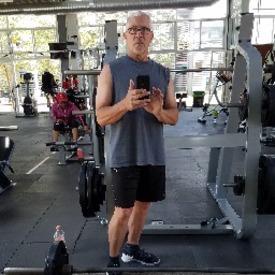How long do you stick with a program before mixing it up?

alexmose
Posts: 792 Member
Curious to everyone’s thoughts.
1
Replies
-
As long as I'm still progressing or until I get bored.
5 -
I think a minimum of 2 weeks is needed to evaluate change; often I'll give a month's time worth of consistency to determine how well something is working or not before making a tweak. Too many variables to consider other than just activity (give enough time before jumping the gun & making hasty impractical decisions...need enough logic and both subjective & objective data to convince yourself a change is needed)2
-
As long as I'm still progressing or until I get bored.
Yup same for me. I can usually tell by the first few weeks if a program is not for me. However I have done similar programming for many years now, I am still progressing and getting results, it is in line with my goals and I enjoy it. And while it follows a basic template/pattern I really like that it switches up every 4 weeks to let me try new variations and rep ranges of the main lifts and different accessories.5 -
Curious to everyone’s thoughts.
I stick to any recommended programme I'm willing to commit to for 18 weeks, before I'll switch it up a little, to keep it interesting for me. Lately, my main programme (not the indoor maintenance routines) has been outdoors, which appeals to me. Stamina & endurance has been particularly challenging, because of my location, which is at high altitude, testing my recovery time, following my speed & ball handling incline drills. Strength & resistance, flexibility, stability, balance & coordination - are my maintenance.2 -
For more optimal results, I write my own templates 95% of the time and personally utilize individualized programming based off my data. It's has auto regulation and load management built in so I can regulate proper dosage of useful stress as well as account for unuseful stress of life.
I have a mock meet scheduled in early July which I already have my next two most successful training blocks set to lead me into competing at Raw Nationals in October. So you can see I have short and semi-long term goals in place.
Because my programming is personalized the "mix up" is based on my block and templates. At the end of most templates I have written, I will utilize a pivot week or a wash out week and have templates awaiting my next block of programming for the goal at hand.
4 -
When I realize that I'm no longer sore the day after, even after a really hard, strenuous workout, I assume my body has gotten used to what I am doing and I switch things up.6
-
I have a half dozen exercises I include in my rotation but what I actually do depends on how I feel that day. Today, for example, I did 100 reps of alternating pull-ups and chin-ups for time, 100 bar dips for time and then ran 8 miles. It’s highly likely that tomorrow will be a rest day but it’s not etched in stone.
I call my “program” intuitive training. At age 64, I listen to my body better than when I was younger. My primary focus is cardiovascular conditioning and strength endurance and not preparing for some competition or muscle appearance outcome.7 -
brittanystebbins95 wrote: »When I realize that I'm no longer sore the day after, even after a really hard, strenuous workout, I assume my body has gotten used to what I am doing and I switch things up.
I don't believe that soreness is a reliable indicator. The only time I really get sore is when I need to take a week or two off from training and then dive back in, or if it is a new stressor (such as running if I haven't run for a while).
For strength training, if you are running a progressive overload, the stress/recovery/adaptation cycle can be almost completely without soreness yet still deliver excellent results. If you are managing the load and fatigue properly. I've been lifting for about 2 years now and made substantial gains in strength and muscle composition with very little to almost no soreness along the way.
At age 56, I also listen to my body. Soreness is not a part of the decision-making process at all, unless I it indicates that I did something above normal. If I've introduced a new movement, I might have some for a day or so, but it is the exception, not the rule.
YMMV.
11 -
My primary lifts are always the same...deadlift, squat, bench, OH press, and clean. My accessory work changes all of the time with variations of the same lift...like one day I might do cable rows and the next time I do rows will be 3 pt, etc.
Right now I'm running a heavy cycle with my primary lifts and higher rep ranges for accessory work. I tend to mix up my rep ranges every 6-8 weeks or so depending. Right now my goal is to get my primary lifts back up where they were a couple of years ago, so I'll probably run that rep scheme for awhile.4 -
I run the same workouts until I get bored with it which always seems to be between 8 and 15 times. Then I change most of the exercises, lower the weights and slowly try to increase weight and/or reps over another 8-15 workouts.0
-
I joined MFP well over one year ago and so far I did not find a reason to make any changes to their calculations. Over time I have made small, seasonal adjustments on my macro percentages - otherwise the MFP approach suites me very well indeed.3
-
I change up my lifting workout every 4-5 weeks.0
-
I did NROL Strong for 10 months (the entire program) but it changes every 4 weeks. I did SC Advanced after that, and only did it for 8 weeks. I did not care for it, I tried to stick out the whole 12 weeks but I missed NROL. The workouts were super long for me.
So I went back to NROL (the supercharged book layout), which has you write your own. I'm able to write my own programs, based on the NROL framework/pattern, and incorporated glute work I learned in SC. Since it changes every 4-6 weeks, I'll probably stick with the same "program" for another 9-12 months, but the exercises change.0 -
brittanystebbins95 wrote: »When I realize that I'm no longer sore the day after, even after a really hard, strenuous workout, I assume my body has gotten used to what I am doing and I switch things up.
Soreness isn't a good indicator. Some of it is genetic and some is just based on changing a stimulus that your body isnt' used to. For example, the only thing that ever makes my upper body sore is GVT (10x10). Outside of that hell, nothing makes my upper body sore. But my lower body is always sore after a good lifting session.
OP, I change when I stop making progress. But then again, I alter my programming based on time of the year. When it's warmer, i move to less lifting as I add in a bit more cardio in the form of sports.1 -
I change my routine about every 4 weeks. It isn't optimal, but neither am I, hence the need to change up more often. listening to what my body is telling me means more today than it did a few years ago.0
This discussion has been closed.
Categories
- All Categories
- 1.4M Health, Wellness and Goals
- 398.2K Introduce Yourself
- 44.7K Getting Started
- 261K Health and Weight Loss
- 176.4K Food and Nutrition
- 47.7K Recipes
- 233K Fitness and Exercise
- 462 Sleep, Mindfulness and Overall Wellness
- 6.5K Goal: Maintaining Weight
- 8.7K Goal: Gaining Weight and Body Building
- 153.5K Motivation and Support
- 8.4K Challenges
- 1.4K Debate Club
- 96.5K Chit-Chat
- 2.6K Fun and Games
- 4.8K MyFitnessPal Information
- 12 News and Announcements
- 21 MyFitnessPal Academy
- 1.6K Feature Suggestions and Ideas
- 3.2K MyFitnessPal Tech Support Questions











